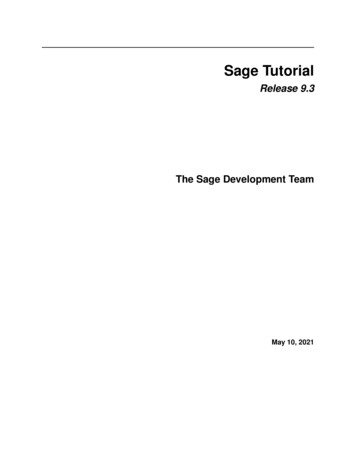
Transcription
Behaviorism in Early interventionPhillip S. Strain, Allegheny-Singer Research Institute,Scott R. McConnell, University of Minnesota, Judith J. Carta,Juniper Gardens Children's Project, Susan A. Fowler, Universityof Illinois, Champaign, John T. Neisworth, Venn State,and Mark Wolery, Allegheny-Singer Research InstituteA consistent and persistent devaluation and misunderstanding of behaviorism, the behavioral approach, and its application to early childhood specialeducation exists among many professionals in the field. In this article weexplore common criticisms of behaviorism and present reactions. In addition, we identify and describe the critical features of the behavioralapproach and their similarities to early childhood special education. Finally,we provide examples of the influence and application of the behavioralperspective in early childhood special education. In the conclusion of thisdiscussion, we assert that the behavioral perspective has contributed substantially to improving the lives of young children with developmentaldelays and disabilities and their families. As such, behaviorism has utilityin the design and implementation of early childhood special educationservices.In the past few years we have experienced an increasing tendencyfor early childhood special educators to dismiss summarily the contributions of the behavioral approach to assessment and intervention.The concern we have is not related to questioning and debate, whichseems most helpful to the discipline, but to an apparent willingnessto end debate and question. For some, it appears that behavioral isequated with "bad," "inappropriate," "extreme," "overly complex,"and similar descriptors. This is often manifest in statements such as:"I wouldn't adopt this book, it's too behavioral." "This behavioralprogram is turning children into robots." "This behavioral approachis too simplistic; it's dehumanizing." "We don't allow any behavioralTECSE 12(1), 121-141 (1992) PRO-ED Inc.121Downloaded from tec.sagepub.com at SAGE Publications on August 7, 2015
122, TOPICS IN EARLY CHILDHOOD SPECIAL EDUCATION 12:1procedures here." "This behavioral stuff is nothing more than M & Mtherapy."These comments are disturbing on at least three grounds. First,they categorize behavioral approaches along a narrow, homogeneouscontinuum. Thus, all behavioral procedures are inappropriate, banned,or trivial. We acknowledge that some behavioral procedures mayqualify for such ignoble distinction; others certainly do not. Second,the comments are nonempirical. If behavioral procedures and organizational schemes yield less fruitful outcomes than other approaches, thenthey should be replaced. But what are the alternatives, and where arethe comparative data in their favor? Finally, these comments cast aspersion on those who advocate and practice behavioral approaches. Goodwill toward children and families does not reside with any particularorientation toward human behavior or early intervention. Havingstated what we think is generally wrong about the summary level ofcriticism, we explore in more depth the nature of the criticism.The Inaccuracy of Specific ChargesAgainst BehaviorismA number of charges have been leveled against the behavioral perspective. Some charges are simply wrong and may reflect a lack ofunderstanding of the basic tenets of behaviorism. Others reflect differences in conceptual or philosophical perspective; behaviorists and nonbehaviorists agree on the basic datum, but disagree on its relative valueor importance. Although the particulars may vary among critics, fourcharges are typical: (a) Behaviorism is a simple stimulus-response (S-R)approach, offering an overly mechanistic model of human behavior;(b) behaviorism offers a world view that overemphasizes the externalcontrol of behavior and thus is dehumanizing; (c) behaviorism is toocomplex and esoteric, without explicit links to problems of application; and (d) behaviorism is limited in its potential application andcannot address the range of "real-world" problems that confront fieldslike early childhood special education.In this section, we review these criticisms and offer an alternative view of the extent to which critics are describing true features ofthe behavioral perspective. We summarize the value (for research,conceptual clarity, and program development) of each feature, highlighting the ways the behavioral perspective may contribute to theongoing enhancement of early intervention.Downloaded from tec.sagepub.com at SAGE Publications on August 7, 2015
BEHAVIORISM, 123Behaviorism is a Simple S-R ApproachPerhaps the most common criticism of behaviorism is that it isbased on a simplistic, mechanistic, stimulus-response model of humanbehavior. Critics suggest that behavioral models include only ananalysis of discriminable environmental events (i.e., stimuli) and features of an individual's behavior (i.e., responses) that occur in closetemporal proximity. This charge suggests that behaviorism is deterministic, or that a given stimulus always produces a particular response.Given this assumption of determinism, critics argue that the behavioralmodel fails to account for (a) individual differences, (b) the varietyof behavior for any individual, and (c) the rich fabric of other factors(e.g., genetics, stage of cognitive development, attachment history,presence or absence of significant life stressors) that influence behavior.In short, critics charge that the behavioral model is too simplistic, failingto reflect the complex and reciprocal influences of history, environment, individual, and behavior.We assert that these charges are inaccurate and are not legitimate criticisms of behaviorism. Critics often confuse a Pavlovian/Respondent (S-R) model with the operant behavioral model. In theoperant paradigm the S refers to an antecedent or discriminative stimulus that sets the occasion for a behavior. An antecedent becomes adiscriminative stimulus (i.e., is empowered to occasion a behavior)when a behavior is consistently reinforced in its presence and not reinforced in its absence. For example, the sound of the doorbell sets theoccasion (is the discriminative stimulus) for our opening the door (ourresponse). This is so because the behavior is reinforced. Likewise, welearn (are "conditioned") to respond to our own names and not others,to discuss some topics with some people and not others, and generallyto behave differentially and somewhat predictably under differentialcircumstances (stimulus conditions). Thus, the operant model is fardifferent from the reflex or Pavlovian model wherein behavior is elicitedor forced by a stimulus (e.g., salivate to a bell). A fundamental distinction is that no new behavior is learned through Pavlovian conditioning; essentially the same response becomes paired with more stimuli(e.g., salivate to a bell, bright light, special signal, etc.). In operantlearning, whole new repertoires are shaped by the contingencies thatexist between the antecedents and consequences of a behavior (e.g.,child learns to say "daddy" in the presence of her father but not ofother men). (See Ferster, Culbertson, & Boren, 1975, for an excellent discussion of the basic distinctions between respondent and operantDownloaded from tec.sagepub.com at SAGE Publications on August 7, 2015
124, TOPICS IN EARLY CHILDHOOD SPECIAL EDUCATION 12:1learning and Neisworth, 1985, for application of operant approachesin early childhood education programs.)Conceptually and empirically, behaviorism is a science of probability and a means of understanding how we can change the oddsthat a particular event will occur (or not occur) now and in the future.Indeed, powerful behavioral interventions with preschoolers fail toshow a deterministic S-R relationship. If we examine peer-mediatedinterventions for social interaction (Odom & Strain, 1984) or timedelay procedures used for instruction (Wolery, Holcombe, et al., inpress), we find children's behavior is quite variable, changing fromminute to minute and day to day. The variability is reasonable,expected, and may be an asset to the child.Further, behavioral educators and psychologists do not focus onlyon stimuli and responses closely associated in time (as is the case withtrue S-R models). Numerous investigations have assessed the effectsof a broad range of historical, socioeconomic, ecological, and behavioral variables on the behavior of individual children (e.g., Carta,Sainato, & Greenwood, 1988; Odom, Peterson, McConnell, &COstrosky, 1990). This research illustrates the extent to which behavioral principles can be applied to the analysis of both contemporaneous and historical factors that affect an individual's behavior at anyone point in time.In some of his last writings, B.F. Skinner spoke directly and eloquently regarding the importance of variation in an individual's patterns of behavior and responses to specific stimuli, and argued for acomplete analysis of both genetic, cultural, and experiential variables(Skinner, 1990). To summarize his thoughts, behavior that is determined by a limited range of stimuli, that can be acquired only by directexperience, and that never varies in its occurrence or form is not likelyto be behavior that helps an individual—or a culture—grow and adapt.And if adaptive behavior is multidetermined, probabilistic, and varied,a science of human behavior must be able to describe and accountfor these factors. Indeed, behaviorism is one such model.Behaviorism Overemphasizes External Controlof Human BehaviorThis charge suggests that behavioral approaches employ a viewthat emphasizes the controlling influences of external or environmental factors on individuals' behavior. Critics state it discounts individuals'Downloaded from tec.sagepub.com at SAGE Publications on August 7, 2015
BEHAVIORISM, 125ability to control their own behavior. Extreme versions of this chargeassert that behaviorism denies the existence of "internal events" likethoughts, feelings, emotions, attributions, and fears, focusing only onenvironmental variables that elicit and reinforce specific behaviors.Fundamentally, this charge is accurate, but only to a point.Behavioral approaches do emphasize the role of external variables(e.g., setting events, discriminative stimulus, reinforcers, and punishers) in the shaping of an individual's behavior; typically, internalfactors like intelligence, creativity, or moral development are seenas hypothetical constructs or epiphenomena that can be explainedmore adequately by accounting for an individual's genetic makeup andexperiences or learning history. The behavioral model suggeststhat the environment—or, specifically, an individual's history ofreinforcement—is largely responsible for shaping and governing anindividual's behavior.This does not mean, however, that behaviorists accept the implication that the model is dehumanizing. First, it is not true that behaviorism rejects all "internal events" (Neuringer, 1991). Thoughts,feelings, and emotions are real and influence individuals' behavior.However, behaviorists assume that internal events are behaviors(Skinner, 1953); that like any other, more observable, behavior (e.g.,initiating social interaction, talking, constructing buildings withblocks), thoughts, feelings, or other internal events are learned throughinteraction with others and the environment.Moreover, behaviorists assert that a focus on the influence ofexternal variables offers a functional view of individuals. Manytheorists (e.g., Bijou & Baer, 1978; Bronfenbrenner, 1977; Samaroff,1986) agree that, to some extent, interactions with the environmentguide our development. From early infancy, behaviors develop thatgive us access to food, warmth, love, and affiliation; over time, thesebehaviors elaborate to accommodate other reinforcers and to encompass familial and cultural norms. By ultimately linking behavioraldevelopment to external variables, behaviorism offers an organizedand complete model for understanding the ways individuals survive,grow, and become instrumental in their interactions with the physicaland social environment.This environmental view is essentially optimistic; it suggests that(except for gross genetic factors) all individuals possess roughly equalpotential. Our society includes individuals who do not acquire essential developmental competencies, fail to make adequate adjustmentto school, succeed at lower levels in vocational settings, and experienceDownloaded from tec.sagepub.com at SAGE Publications on August 7, 2015
126, TOPICS IN EARLY CHILDHOOD SPECIAL EDUCATION 12:1little happiness as adults; unfortunately, these poor outcomes are oftenassociated with factors like disability, race, and socioeconomic status.Rather than assuming these individuals lack some essential internalcharacteristics, behaviorists assume that the poor outcomes originatein the ways the environment and experience shaped individuals' current behavior. Once these environmental and experiential factors areidentified, we can design prevention and intervention programs toimprove the outcomes for individuals who should, on every other basis,have opportunities for good development, success, and adjustment.Thus, the emphasis on external control in the behavioral approachis not dehumanizing; rather, it offers a conceptual model that celebratesthe possibilities for each individual.A closely related criticism of behaviorism is that it does not "follow the lead" of the learner, but instead is overly directive. This isa curious criticism, as we know of no other theoretical orientationthat places so much emphasis on understanding the individual in relation to his or her environment. Moreover, behaviorists (e.g., Halle,Alpert, & Anderson, 1984; Hart & Risley, 1975; McGee, Krantz,&C McClannahan, 1985) have been the leaders in the design andempirical evaluation of teaching strategies that have relied exclusivelyon child initiations toward the social and physical environment tooccasion instruction.Behaviorism Is Too Esoteric and ComplexThis charge asserts that behaviorism, as a conceptual and empirical body of knowledge, is overly complex for practical application.In large measure, this charge is directed at the scientific foundationof behavioral approaches and questions whether research on nonhumansubjects and basic learning processes is relevant to the problems ofchildren with disabilities and their families.Behaviorism does present a unified view of learning and behaviorthat encompasses both humans and nonhumans. Many basic principles of behavioral psychology were identified, and continue to bestudied, using nonhuman subjects. Also, behaviorism takes a scientific approach to understanding behavior and integrates knowledgefrom basic and applied research. However, behaviorists do recognizedifferences between the behavior of humans and other organisms andbelieve that learning processes are not identical across species. Indeed,there is a rich tradition of human and nonhuman behavioral research,Downloaded from tec.sagepub.com at SAGE Publications on August 7, 2015
BEHAVIORISM, 127both basic and applied. A strong tie exists between basic research conducted with animals and applied research with preschool children, butthere also is explicit attention to translating fundamental phenomenaidentified in laboratories to practical, and acceptable, procedures foruse with humans (Tawney &c Gast, 1984).Behaviorism Is Limited in Its Scope of ApplicationThis charge, though common, appears to originate from datedand incomplete information. On the contrary, behavioral proceduresare used with an array of problems in varied settings. In schools,behavioral researchers have studied problems of developmental andacademic competence, acquisition of social interaction and school survival skills, increased independence, self-management, and peermonitoring. In communities, behavioral applications have focused onincreasing cooperation among ethnically diverse groups, improvingmaintenance of the physical environment, improving pedestrian andworker safety, rehabilitating criminal offenders, and reducing the riskof AIDS transmission.Based on this review of the common criticisms of behaviorism,we conclude that much of the criticism leveled at behaviorism isunfounded and is the product of inaccurate understanding of the model.The next section reviews the critical features of the behavioralapproach.Critical Features of BehaviorismSeveral features of behaviorism make it well suited to early intervention. Indeed, because behaviorism and early intervention maturedsimultaneously, the critical features of each are almost indistinguishable. Many of the features we use to define early intervention havebehavioral roots; for example: (a) a theory of developmental retardation that focuses on observable, and thus changeable, conditions;(b) a research methodology that focuses on the idiosyncratic patternsof children's behavior through the use of repeated, intensive assessments; (c) an assessment approach that focuses on factors that causeor maintain a child's behaviors; and (d) an intervention approach thatemphasizes quality of a treatment's implementation, its social acceptance, and its effectiveness.Downloaded from tec.sagepub.com at SAGE Publications on August 7, 2015
128, TOPICS IN EARLY CHILDHOOD SPECIAL EDUCATION 12:1Behavioral Theory of Developmental RetardationA primary contribution of behaviorism to early intervention isits conceptualization of the developmental process for typical (Bijou& Baer, 1978) and atypical child development (Bricker, 1989). Whenthe field of early intervention was in its infancy, Bijou (1966) introducedthe term developmental retardation to replace the term mental retardation. This change is terminology was a reaction to the then currentapproach to treating mental retardation as a hypothetical constructbased on biological abnormalities such as brain dysfunction and corresponding defective intellectual capacities. The term developmentalretardation shifted the focus from organismic and unobservable variables to the observable conditions that produced "retarded" behaviors.From the behavioral perspective, a "retarded" child acts as he doesnot because of the condition of retardation but because he has a "limitedrepertory of behavior shaped by events that constitute his history"(Bijou, 1966, p. 2). In other words, the child has yet been taughtto behave otherwise (Bijou, 1966; Sailor & Guess, 1983; Vincent,Salisbury, Strain, McCormick, & Tessier, 1990). Thus, an intervention must be based not on past history or on assessed mental statesbut on critical relationships the child has with the environment (Bijou,1966; Sidman, 1960; Vincent et al., 1990). So, given a child withdelays, behavior-based intervention changes the child's developmental trajectory by intervening in those interactions that appear to retarddevelopment.Single-Subject Research MethodologyA second contribution of the behavioral approach is the use ofresearch designs that value the individual. A fundamental principleof early intervention is the importance of the unique needs of eachchild and family and developing individualized programs to meet thoseneeds. In single-subject studies, as with early intervention programs,within-subject variability is worthy of careful examination because itrepresents an individual's response to some variable(s) that should beexplained. Thus, behaviorists engage in intensive assessment of individuals to monitor programs and to understand the factors that influence the child's behavior. These frequent measurements are used tochange ineffective interventions. This approach shifts the "blame" forDownloaded from tec.sagepub.com at SAGE Publications on August 7, 2015
BEHAVIORISM, 129lack of improvement from some trait of the child (e.g., an attentionaldisorder) to some fault of the intervention (Baer, 1981).Behavioral Approach to AssessmentThe cornerstone of the behavioral approach to measurement isfrequent assessment with intensive observations to identify controlling and maintaining environmental factors. This approach shifts thetraditional focus of assessment from infrequent sampling of unchangeable traits to the more frequent assessment of manipulable elementsof the environment (e.g., interactions with caregivers or peers that setthe occasion for language use, events that precede episodes of aberrant behavior, or classroom arrangements that promote high levelsof engagement). The behavioral approach to assessment includes functional and ecobehavioral assessment.Functional assessment is the process of determining the relationship between a child's behavior and the environmental factors thatmay cause or maintain it (Wolery, Bailey, & Sugai, 1988). Often, functional assessments are used to identify events that trigger children'schallenging behaviors and to develop predictions about conditionsunder which those behaviors are likely to occur (Durand & Carr, 1987;Horner, Albin, &c O'Neill, 1991). Functional assessment of a challenging behavior such as severe self-injury would include a description ofwhen, where, with whom, and under what conditions the behaviorwould occur. This approach provides a means of determining the possible functions or maintaining consequences of behaviors. Thisapproach is preferable to use of intrusive procedures or more traditional medical interventions.Similar to functional assessment, ecobehavioral assessment seeksto identify functional relationships between environmental events andchildren's behavior. But ecobehavioral analysis attempts to studybroader contextual or setting events that may affect behavior (e.g.,Brown, Bryson-Brockman, & Fox, 1986; Morris & Midgley, 1990).Ecobehavioral assessment has often focused on behaviors that shouldbe accelerated such as communicative behaviors (Hart & Risley, 1989),active engagement (Carta, Atwater, Schwartz, & Miller, 1990; Cartaet al., 1988), or peer interaction (Odom, Peterson, McConnell, &Ostrosky, 1990a).Ecobehavioral analysis holds several advantages. First, it allowsthe user to describe a behavior and its immediate and subsequent situ-Downloaded from tec.sagepub.com at SAGE Publications on August 7, 2015
130, TOPICS IN EARLY CHILDHOOD SPECIAL EDUCATION 12:1ational events. If these data records extend across several days or weeks,they lend themselves to the study of environmental effects distant intime from a particular target response (e.g., Wahler & Fox, 1981).Second, use of ecobehavioral assessment within experimental studiescan document important features of the independent variable and allowquantitative comparisons of the interventions between baseline andexperimental phases. For example, several aspects of classroom ecology and their effects on child behaviors could be simultaneously monitored within a manipulation of classroom organization. Third, useof ecobehavioral assessment within experimental studies increases theability to explain changes in behavior that emerge, and also variabilityin that change. For example, when applied to a problem such as schoolfailure by children in schools from low-income areas, Greenwood(1991) found many contrasting classroom ecological features. Whenthose ecological features were manipulated, specific ecobehavioralinteractions were found to covary with specific academic outcomes.Thus, ecobehavioral analysis offers early intervention a powerful,expanded process measure for studying the delivery of treatments andtheir effects on children's outcomes.Behavioral Approaches to InterventionThe goal of behavioral approaches is the delivery of quality services to children. Toward this end, however, behavioral approachesare guided by three fundamental principles that undergird appliedbehavior analysis as a field: treatment integrity, acceptability, andeffectiveness.Treatment integrity is the degree to which an intervention is delivered as intended. Frequently, investigators assumed that, with sufficient training and support, treatments would be implemented asplanned. Numerous studies, however, documented that this is not thecase (Gresham, 1989). Thus, carefully conducted behavioral intervention studies make frequent assessments of treatment fidelity. Suchpractice is important to planners and implementers of intervention programs. These data may help explain the lack of success with someprogram participants—they did not receive the intervention as planned.Also, the data may identify features of interventions that practitionersare likely to implement with fidelity and the ones they are likely toabandon or use inaccurately. Finally, when fidelity measures are usedin conjunction with student outcome data, the most essential featuresDownloaded from tec.sagepub.com at SAGE Publications on August 7, 2015
BEHAVIORISM, 131of interventions may be documented and used when disseminatinginterventions.Behavioral researchers are concerned with the acceptability of theirinterventions by consumers, (i.e., their social validity) (Schwartz &CBaer, 1991). This concern has been a persistent theme in behavioralstudies over two decades (Kazdin, 1981; Repucci &C Saunders, 1974;Wolf, 1978). Behaviorists have invested considerable energy to identify the features of interventions that are accepted by consumers (e.g.,teachers, students, parents) and features they found unacceptable.Behaviorists also are concerned with the social validity of the goalsof their treatments (e.g., How important do consumers consider thebehavioral changes caused by our interventions?) and the magnitudeof the effects obtained (e.g., Do consumers notice a change in individuals receiving our treatment and do they appreciate the difference?).Each of these questions must be answered by early interventionistsas well as behavior analysts (Miltenberger, 1990).A third, and probably the most fundamental principle of behavioral approaches, is concern for treatment effectiveness. This principle above others is the determining factor that guides the behavioristresearchers or practitioners in deciding whether an intervention shouldbe maintained or modified. This concern that children's behaviors arechanged in desirable directions was described more than 20 years agoby Baer, Wolf, and Risley (1968): "If the application of behavioraltechniques does not produce large enough effects for practical value,then application has failed . . . . Its practical value, specifically itspowers in altering behavior enough to be socially important is the essential criterion" (p. 96). This same concern for whether a program worksmust also drive the early interventionist in maintaining accountabilityfor services. Empirical evidence for effectiveness must guide the selection of interventions as well as the decisions to maintain or changeprograms.The Behavioral Perspective:Examples of ApplicationTo illustrate the relevance of the behavioral perspective to earlyintervention, we identified six functions performed by professionalsin early intervention. They appear to engage in two major development functions and four implementation functions; these are describedDownloaded from tec.sagepub.com at SAGE Publications on August 7, 2015
132, TOPICS IN EARLY CHILDHOOD SPECIAL EDUCATION 12:1below. Other functions exist such as interacting with members of otherdisciplines, ensuring interagency coordination, developing and influencing policy, providing staff development and experiences, informingthe public, and many others. However, these activities frequently occurto ensure that the six functions listed below are accomplishedadequately.Development Functions of ProfessionalsDeveloping Model Services. Service development is best accomplished when a unifying conceptual or philosophic base is used to makedecisions about the nature and manner of service delivery (Dunst,Snyder, & Mankinen, 1989). The pertinent question is, Can thebehavioral perspective provide a unifying conceptual foundation formaking decisions about service provision? Experience suggests thatthe answer is yes; several well-established programs support this conclusion. Among others, these include the Teaching Research DataBased Classroom Model (Fredericks et al., 1980); Learning Experiences. . . An Alternative Program for Preschoolers and Parents (LEAP)(Hoyson, Jamieson, &c Strain, 1984); the comprehensive programdeveloped by Lovass (1987); and the Preschool Training Project(Dunlap, Robbins, Dollman, & Plienis, 1988). These models vary interms of primary goals, site of services, nature of family involvement,staffing patterns, curricula used, and many other features. However,they share several characteristics, such as a commitment to producing outcomes, careful identification of target skills, understanding children's behavior in the contexts of their natural environments, systematicmanipulation of children's experiences to ensure acquisition of skills,attention to producing generalized outcomes, frequent and ongoingassessment of the effects of intervention, and adjustment of the intervention based on child progress. These programs have been thoroughlyevaluated and shown to produce durable and desirable changes in outcomes. Thus, the behavioral model is sufficiently flexible and comprehensive to be used as the conceptual base for service development.Developing Curricula. In addition to devising service models, thebehavioral perspective has influenced curriculum development activities. Examples of curricula that were influenced by the behavioralapproach are: Teaching Research Curriculum (Fredericks et al., 1980);Downloaded from tec.sagepub.com at SAGE Publications on August 7, 2015
BEHAVIORISM, 133Programmed Environments Curriculum (Tawney, K n a p p , O'Reilly,& Pratt, 1979); H I C O M P Preschool Curriculum (Willoughby-Herb& Neisworth, 1980); Evaluation and Programming System for Infantsand Young Children (Bricker, Bailey, Gunnerlock, Buhl, & Slentz,1986); The Integrated Preschool Curri
Behaviorism in Early intervention Phillip S. Strain, Allegheny-Singer Research Institute, Scott R. McConnell, University of Minnesota, Judith J. Carta, Juniper Gardens Children's Project, Susan A. Fowler, University of Illinois, Champaign, John T. Neisworth, Venn State, and Mark Wolery, Allegheny-Singer Research Institute A consistent and persistent devaluation and misunderstanding of behavior-










